I'm at the Bonghwang Motel, just down the street from the Havana, where that unpleasant woman works. Only W40,000 a night at Bonghwang. The fairly laid-back dude who manages the place was outside sweeping when I lumbered up: he spoke with a heavy southern accent but was very nice. He showed me a room with a bed, then decided the room would be too cold since it lacked an ondol (traditional floor heating), so he showed me to a bedless room (Korean-style, sleep on the floor), then he took me up one floor and showed me to another bedless room before letting me go.
Naver once again jiggered the distances, claiming that today's walk was not 23K, but only 19K, as you see below (map image). I did walk a few extra kilometers, though, because I'd gotten to my destination ridiculously early—before 11 a.m. So I went to a pharmacy to buy some more waterproof "aqua" bandages (it was a quiet pharmacy, and the older lady running the place was friendly and chatty), then I resupplied myself at a local convenience store and, since it was after 11 a.m. by that point, I went to have lunch at my favorite local Chinese place... only to discover it had been bulldozed to the ground. Just my luck: the cosmos is always thwarting me.
Fortunately or unfortunately, there was another Chinese place a couple lots down, so I went there. They've got good fried rice with lots of wok hey, but their jjajang-myeon somehow managed to be flavorless. I normally love jjajang-myeon, but it was as if I'd paid W7000 for a bowl of fog. I missed the other, now-defunct restaurant.
After lunch, I still had too much time on my hands, so I went exploring to see what my other motel options might be. And that's how I stumbled upon Bonghwang, a "biketel" catering to cross-country bikers going south to Busan or north to Incheon. I knew better than to try the motel before 2 p.m., though, and since I still had almost two hours, I decided to keep walking, both to kill time and to digest my carby lunch.
So I walked a slow loop that look me across the Nakdan Dam, taking pictures as I went. I paused before this dam's hydroelectric-power plant and snapped a few shots. This apparently prompted the young lady working in one of the dam's outbuilding offices to pop out without a coat and ask me whether she could help me by taking some shots of me. I politely declined while noticing she was kind of cute, but she was also way too young for me. I asked her whether she was cold, standing out there in tight pants and a figure-hugging sweater, but she said she was okay. We talked about my walk project; I explained about starting in October, getting injured, then restarting at the end of November. I told her I'd been by this way several times and was a little bit familiar with the region. I asked her again whether she was cold. She again said she was okay; I joked that she must be from New York. She laughed and told me about a temple that was nearby; it was called Ma-ae. Since I don't know the hanja for Ma-ae, I jokingly guessed it meant "devil love (마애/魔愛)," i.e., (my) love of the devil, or maybe the devil's love (of me). I didn't give this thought voice, though; it would've been a lame joke, and the poor girl was freezing. Anyway, I thanked the young lady for her explanation and let her retreat into her warm office while I went in search of Devil Love Temple.
It turned out to be right next door to the dam, but even though the lady had said the temple was centuries old, a lot about it simply didn't look right to me. The main dharma hall's color scheme, for example, was varying shades of brown from the unpainted(?) brown wood. Korean Buddhist temples are usually red-brown with almost-pastel colors adorning them: blue-green, yellow, white, etc. There was none of that—just brown. Sure, there are temples that are exceptions (I saw quite a few on Jeju Island), but as a rule, most Korean temples aren't brown. The temple grounds also had one modern building, which only heightened the sense of incongruity and wrongness. I didn't see any monks or nuns bustling about, either, but the modern building's parking lot was full of cars, so somebody was home. Probably laypeople.
I regretted not taking a picture of the young lady. I'm already starting to forget what she looked like. Not that I would've started anything with her; as I said, she was too young.
Last night at Libertar, before I went to sleep, I started compulsively picking at a callus on my right big toe. This callus had nothing to do with my injury, nor with my diabetic ulcer; it was just a random thing. Nevertheless, it annoyed the hell out of me, so as is my wont, I started picking at it. My brain was screaming at me to stop because these compulsive-picking sessions never end well. Just clip off the callus! yelled my brain. A perfectly rational thought that most reasonable people would heed. I ignored my brain's entreaties, though, and eventually paid the price: with a satisfying rip, a chunk of callus came off my toe, followed by big, fat droplets of dark blood. Fuck, another bleeder. And I had no one but myself to blame. As usually happens in such cases, I had once again ripped off too much skin.
I hopped across the floor of my room at the pension, leaving heavy droplets of blood to mark my path. I grabbed some wet wipes, cleaned the floor, and hopped back to the couch to minister to my toe, stanching the bleed with a combination of "aqua" bandages and thick-gauze bandages (so you now see why I needed to buy more waterproof bandages today). Several layers of bandages and tape were enough to stop any further leakage, and when I checked my bandage this afternoon after walking over 21K, I saw to my delight that there had been no more bleeding. My wool sock was pristine (on the outside at least), and while some blood had welled to the surface of the bandages, nothing had seeped through. Thank Cthulhu. I'm leaving the bandages on and not washing my feet so that the dried blood has a chance to scab over and create a seal. Tomorrow should be no worse than today. Theoretically.
Which brings me to the issue of laundry, washing, and body odor. Because I restarted the walk so late in the year, I haven't really had to worry about my usual sweatiness and funk. I'm also wearing layers of clothing on these hikes, so when I reach my destination for the day, I simply strip off any inner layers and wear only my outer layers. The only daily laundry I do is my underwear; everything else is more or less okay so far. I might do my laundry after the 36K segment, but we'll see. I might be able to ride the bus home from Andong without worrying about being too stinky. One of the advantages of distance walking in cold weather.
Otherwise, today was another straightforward walk. Tomorrow's segment will be a bit strange: it's 25K to the Bobos Motel, which I've never been to before. Bobos is in the same neighborhood as Sangju Bus Terminal (I'm technically in Sangju now); my turn east toward Andong will happen the day after tomorrow, when I do the big 36K segment. After that, there'll be one last rest day, then the final two days: 30K and 27K. Then a bus home the same day (December 10). Back to work on the 11th.
Hard to believe this is almost over.
 |
| I did more than 19K, though. Closer to 22K. |
 |
| about 4500 calories total |
 |
| crossing Gumi Dam on my way to Nakdan Dam |
 |
| Betelgeuse (L) and Jupiter (R center, slightly diagonally below) |
 |
| church in the morning light |
 |
| the five chairs |
 |
| baesu-mun/배수문, drainage gate |
 |
| Ducks! Lovely, delicious ducks! |
 |
| the first of three bridges at the end of the walk |
 |
| in town at my destination |
 |
| Nakdan Dam from a distance |
 |
| Sangju, Nakdan-myeon: the kind of site I could spend all day photographing |
PHOTO ESSAY
 |
| The walk out from Libertar Pension to the dam was well lit, and there were plenty of barking dogs. |
 |
| Gumi Dam in all of its morning glory |
 |
| winch tower (foreground), observation deck (center, not open at this hour), winch tower (background) |
 |
| Sirius, Betelgeuse, Jupiter—my travel companions in the western sky (plus Orion's belt and sword) |
 |
| little glowing lights along this part of the path away from Gumi and Libertar |
 |
| Jupiter, front and center |
 |
| one of those bunker-like mystery buildings along rivers |
 |
So frustrating that (1) the store across the way (Nonghyeop Hanaro Mart) isn't open at this hour (6:49 a.m.), and (2) there's no way across the freeway for us proles. |
 |
| Another eaten-by-acid boy. I'm beginning to wonder about that turtle. |
 |
| The boy's left arm is practically gone. I mean, Jesus. |
 |
large, white font: the Dogae (Village) Observation Deck smaller, black font: The village where you want to stay—a village with culture!
|
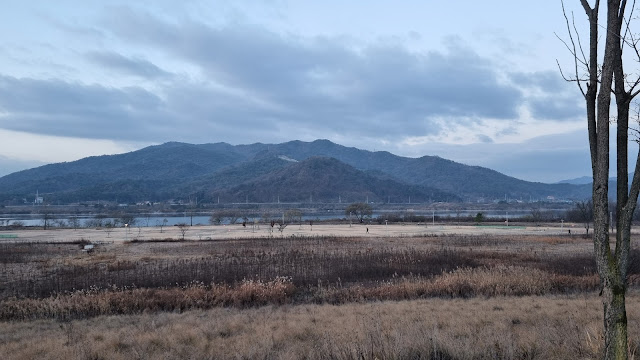 |
| Across the river valley... it can only be... |
 |
| ...fucking park golf. |
 |
| Now, everything's being eaten by acid. |
 |
| A-frame, wheelbarrow, supplies—put aside for winter? |
 |
| Who could miss the chance to record winter conditions like this? Utility building, harvested ground, bridge, church. |
 |
| church at dawn (7:34 a.m.), but my camera must've been a bit tilted |
 |
| a little ramp up |
 |
| looking toward the sunrise |
 |
| Even post-harvest, the ground is fascinating. |
 |
| another little crossing |
 |
| the five evil chairs, all in a row, tied to the fence and sentenced to be shot |
 |
| When in doubt, follow the red path. |
 |
| My destination is supposedly 10K away, but I doubt that. |
 |
| Ah, those open-air couches. |
 |
| ...and thus do we go from having no pedestrian lane to having a pedestrian lane! |
 |
It's gone again. This is another quirk of the walk: you accept whatever comes, whatever gifts there are, given or taken away. Besides, we're crossing a small bridge again in a sec. |
 |
| across we go again |
 |
| Yo, creek bed! Someone needs to shave herself down a bit, get things under control. |
 |
| We swing left, then swing around to the right, next to the Nakdong again. |
 |
| a winding walking/biking path down by the bank... lots of peace and quiet for the locals |
 |
| He has his arm again! It's a miracle! But the turtle is back to his smug-asshole self. |
 |
| Technically, I should be walking along the bike path (left lane from this perspective). |
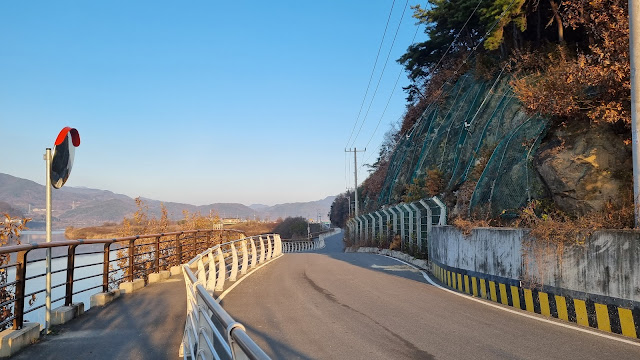 |
| Here we go. |
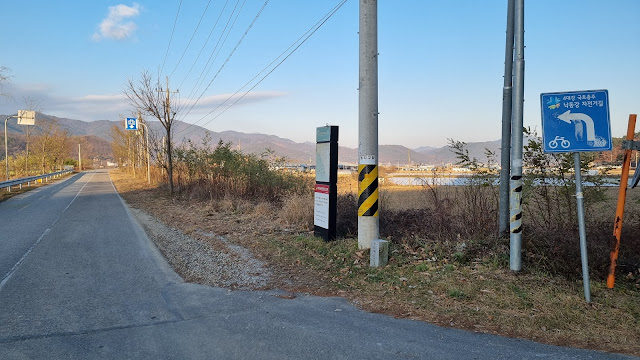 |
| thataway |
 |
| So these drainage gates help with flood control, irrigation, and drainage in urban areas. |
 |
| Is this a really crowded cemetery? I see many myo (tumuli) and things that look like headstones. |
 |
| looming in the back: a solar farm |
 |
| cow house (hello, ladies) |
 |
| See dem burdz? |
 |
| Them's ducks. Hear me? Duxx! |
 |
| How many of you are scheduled to end up smoked, sliced, and packaged? |
 |
| Another obnoxious vehicle approaches. In the pedestrian lane, of course. |
 |
| How many trees got shaved away for the solar farm? I'm not sure I like this trade-off. |
 |
| modern rest area (shwimteo, or possibly a hyugeso/휴게소, "hyoo-geh-soh") |
 |
| This glove had made a significant point. |
 |
| 'nother one comin' |
 |
| With all the channels and artificial ponds, you become very conscious of the role of irrigation. |
 |
| I wouldn't mind a house like this. Strange to photograph it from this angle of approach. |
 |
| What cancer are you beaming into my head? |
 |
| Porta-John |
 |
| Look. Squat terlit. |
 |
| Look closer. |
 |
| It's always about controlling the flow. |
 |
| Hay bales are wrapped to prevent moisture damage (rot, etc.) so farmers have viable animal feed the following year. |
 |
| cell tower |
 |
| The kind of land I love walking through. |
 |
| solar farm across the way... doesn't make me happy |
 |
| Bene Gesserit hand signal, or L.A. gang sign? |
 |
| I'm starting to see these solar farms as blights on the landscape. A bit like wind farms. "Farms." Ha! |
 |
| We've reached the border of Euiseong-gun (Euiseong County). |
 |
| The bottom sign says the Nakdan Dam admin building is 1.9 km off. We'll soon see. |
 |
| the creatively named Nakdong River Bridge (haven't we seen other bridges with this name before?) |
 |
| 낙동강대교/Nakdonggang-daegyo = Nakdong River (Big) Bridge |
 |
| "Hyeokshin Farm Equipment" |
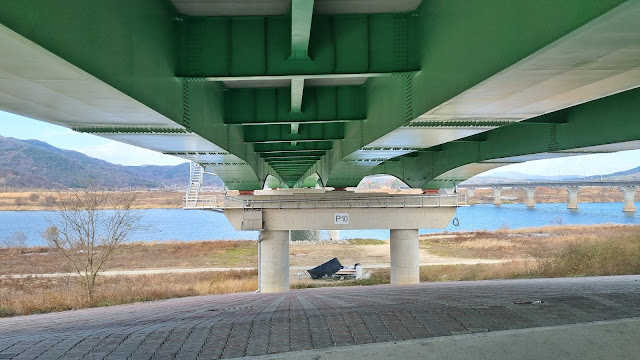 |
| I could be homeless and set up a nice camp here. |
 |
| 낙단대교/Nakdan-daegyo = Nakdan (Big) Bridge, coming up |
 |
I gather that these tents are set up, here and there, along the river for events, activities, etc., but nothing permanent. (Bet it took a lot of brainpower to figure that out, eh?) |
 |
| Across the river are a few motels to choose from; that's also Nakdong-myeon, a village in Sangju City proper. |
 |
| photos rendered as paintings |
 |
| "Euiseong Nakdan Dam Ferry Landing" |
 |
| Whale sculpture? More salt-water beasts by the river? |
 |
| border sign for Nakdong-myeon; bridge with small, stingy shoulders, but not much traffic crossing it |
 |
| Nakdan Bridge |
 |
| Nakdan Dam (낙단보/Nakdan-bo) |
 |
| on the other side of the river now |
 |
| The vertical sign on the building is for the Nakdong River Korean Beef Village; the motel next to it is the Havana. |
 |
| Bull says, "Stay away from the Havana." Right you are, Bull. Right you are. |
The lady who runs the Havana seems a bit mentally slow; a saint might say she's deserving of compassion, but I'm not a saint, and she's got an attitude about foreigners. Alas, she's one of those idiots whose brain shuts down when she sees a foreign face speaking in Korean. What?? This foreigner—how—?? Granted, my Korean's not perfect, but the only people who rudely go, "Huh? Wha...?" are the stupid ones, the ones expecting the foreigner to speak in absolutely terrible-sounding Korean which, strangely enough, stupid people have an easier time of understanding, probably because it meshes with their low expectations. Anyway, I'm glad I didn't use the Havana and its troll this time around. I always enter and leave that place with a feeling of low-grade annoyance.
 |
| on the corner (rooftop, too): bok, the Chinese character for happiness or good fortune |
 |
| a leaf-covered shwimteo |
 |
| for you avid geolocators out there |
 |
| I could stay here all day and photograph every item. |
 |
| behind the mess, some place devoted to health |
 |
| stone rams: guardians; symbols of devotion, good luck, gentleness, harmony, etc. |
 |
| My favorite Chinese spot in this town is gone, razed to the ground. |
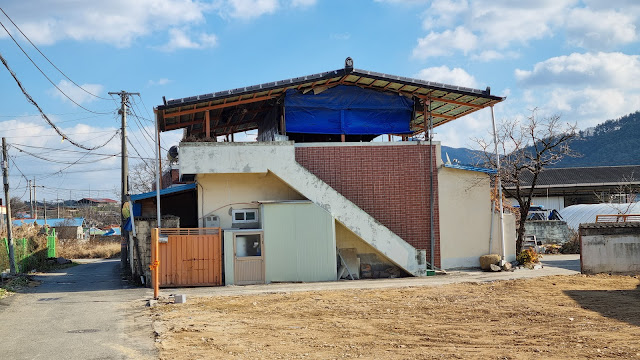 |
| Well, fuck. |
I guess I never bothered to photograph lunch. Not that it mattered, but I'd already described it: fried rice (bokgeum-bap/볶음밥) and jjajang-myeon/짜장면, chewy noodles in black-bean sauce. The fried rice was very good; the noodles were tasteless.
 |
| Bonghwang Motel entrance |
 |
| the whole building front, 12:31 p.m., too early to try getting a room |
 |
| So I walk toward the dam, intent on doing a loop of sorts and ending up back at the motel. |
 |
| looking back at Nakdong-myeon before crossing the dam |
 |
| looks to be a multifamily residence |
 |
Hongilmyo Nakdongjae, a name I can't decipher without deeper study, but it seems to have to do with ancestral shrines, possible meals and rituals (in the Nakdong region), and this could be linked to aspects of Buddhism (the jae character at the very end). |
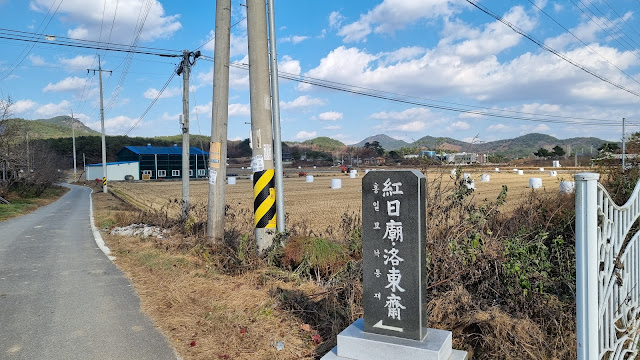 |
| in context |
 |
| We're right next to the dam (right turn up ahead). |
 |
| foreground sign: Nakdan Dam (낙단보/Nakdan-bo) |
 |
| One of the biggest fish ladders I've seen. |
 |
| I don't think any fish is ever getting up this fish ladder. |
 |
| Nor this one. |
 |
| This is that anti-suicide reminder that you are the noble miracle of life. |
 |
| Euiseong-gun forward, Sangju City backward |
 |
| shwimteo and Euiseong-gun border sign |
 |
| Nakdan Dam certification center |
 |
| dam admin building and offices re: hydroelectric power |
 |
The young lady I encountered was stationed in an outbuilding off camera, to the right; she came out without any coat despite the cold; it was tempting to be gallant and offer her my coat. I chose to be a shit instead and simply talked with her as she froze, all while she politely denied that she was cold. This is why I will always be single. And she eventually retreated into her warm building. |
 |
| path to the Ma Ae Bul temple |
The phrase Ma Ae Bul actually comes from 磨崖佛/마애불, which I guess is "stone-cliff Buddha," not "devil-loving (魔愛, see the beginning of this post) Buddha."
Look carefully at both Chinese characters for ma: 磨 (stone) and 魔 (devil). Note how their tops are exactly the same, but the bottom radicals (roots) are different. The first one is seok/석/石, i.e., "stone." The second one is gui/귀/鬼, i.e., "ghost" (as in 귀신/guishin, "ghost"). Etymology can be fun! (If I'm doing it right.)
 |
| approaching the temple |
 |
| Huh... this was one of the temple's few positives: a Buddha image carved into a stone "cliff" face. I wonder how old the image is. |
 |
Many Buddhist temples have a stone basin, usually under a metal pipe driven into a local mountain known to have some kind of spring. To drink water from such a basin is something of a cleansing act (the water's almost always fresh and clean, but sometimes, it tastes a bit like a rusty pipe). When I use the large, plastic ladle to scoop the water, I never let my lips touch the ladle: I press the ladle under my lower lip so that both of my lips are above the rim and have contact with the water; thus do I avoid cooties from Other Members of the Public. I have no idea why this basin isn't positioned to catch water. |
 |
| This looks to be some sort of dharma hall for ceremonies, rituals, etc. |
 |
Encyclopedia Brown and the Case of the Curiously Earth-colored Temple
(as I mentioned above, there are other wood-colored Buddhist temples in Korea, but they're the minority) |
 |
| Write your wish on a roofing tile! Don't give it to the taekwondo team, please! |
 |
| The temple's name is in Korean, Ma Ae Sa/마애사, not Chinese. This also feels wrong. |
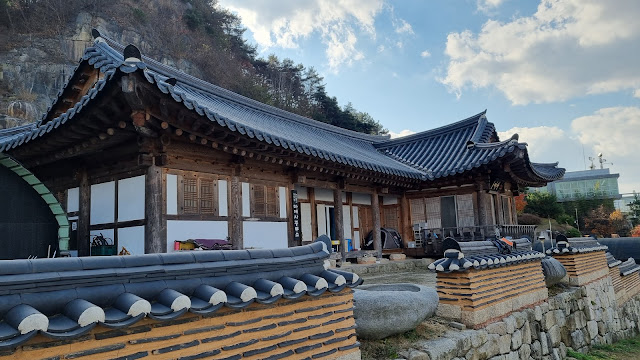 |
| Something just doesn't sit right with me. |
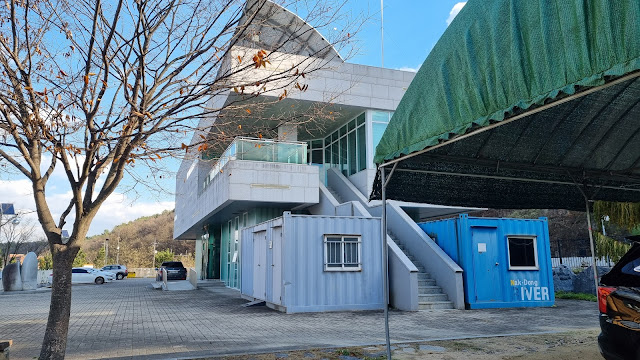 |
| And the modern building on the property! What is this? Am I too attached to name and form? |
 |
| Is this some special sutra written about the Nakdong River? |
 |
The circular bit is the cover of a time capsule not to be opened until 2047, 35 years after 2012. I'll surely be dead by then. I hope it's just a bunch of smelly socks in the capsule. |
 |
| Daehan Buddhism, Jogye Order, Ma Ae Sa (Temple) |
 |
| back down to the dam |
 |
| a grave by the dam |
 |
| a pavilion (maybe a grand, named shwimteo) by the dam |
 |
I'm spitballing, here, but this could be a monument to Nine Mountains Village Teacher (九山村先生 遺墟碑, 구산촌선생 유허비), a famous person who undoubtedly did something patriotic for the country. |
ChatGPT (which may need to be fact-checked) says:
九山村先生 (구산촌선생) refers to a Korean scholar named Seo Geo-jeong (서거정, 1420–1488), a prominent figure in the early Joseon Dynasty. His pen name, "구산촌" (Gusan Village), reflects his literary and scholarly identity. Seo Geo-jeong is best known for his contributions to Confucian scholarship, governance, and literature, as well as for his role in shaping Joseon-era culture and ideology.
Those dates meant he was contemporaneous with Great King Sejong, and thus alive for the invention (c. 1443) and promulgation (c. 1446) of the Korean alphabet.
 |
I think this is gwan su-something, reading right to left: observing-water-something, another observation deck (전망대/jeonmang-dae), not a resting spot (쉼터/shwimteo). |
 |
| crossing back over to Nakdong-myeon, Sangju City, where the motels are |
 |
| According to the sign in the lower left, this is Doosan Park. |
 |
| Bonghwang Biketel (that's "bike-tel," not "bickuh-tel," a bicycle hotel), where I'm staying |
 |
| sports field by the river; the Bonghwang biketel is on the right, in the distance |
 |
| not much bleeding |




















































































































































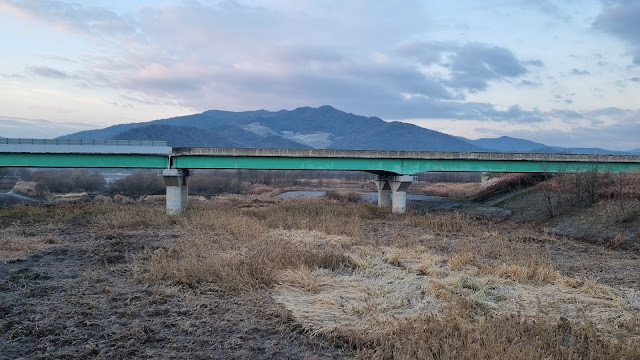





















































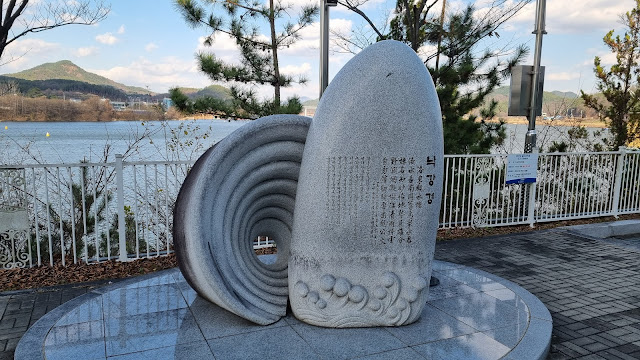




I regret you not taking a picture of the lass as well. I've always been a connoisseur of the artistry of tight pants and sweaters when worn by attractive females. Age doesn't matter; it is just a number. As you know, I self-identify as a 30-year-old lesbian trapped in a man's body.
ReplyDeleteSome dam fine photos today. The church at sunrise is especially nice. Those chairs looked very uncomfortable without a lick of shade. I wonder who uses them and why.
Good luck on today's journey. And as Pink Floyd so famously sang: "Kevin, leave those toes alone!"